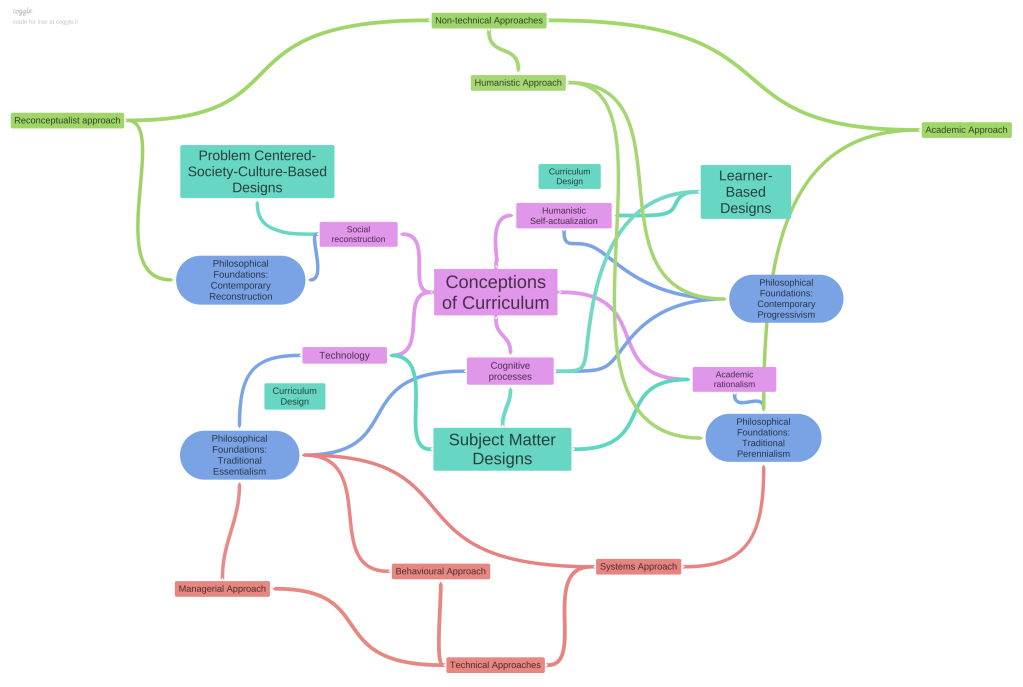
Conceptions of Curriculum
“We are concerned with our shared knowledge and understandings of conditions that benefit children’s learning and growth an understanding that has been reached in modern time and in a variety of cultures and contexts”. –(Samueulsson et al., 2006, p.23)
Conceptions of curriculum can be divided into five perspectives, shown here in mauve, they are Humanistic/Self-actualization, Academic Rationalism, Cognitive Processes, Technology and Social Reconstruction. As Sowell (2005) notes, each conception of curriculum implies “a purpose of education and content from one or more sources to enable learners to reach that purpose” (p.61). As Ornstein and Hunkins (2013) observe, the Humanistic Conception of curriculum stems from the philosophy of Progressivism which emphasizes students’ interests and needs to drive student motivation, emphasizing active participation and meaningful learning, and is interdisciplinary in subject matter, activities, and projects. This conception embraces learner centered curriculum design where the teacher is both guide and resource for the student, but the focus is on hands-on learning and the individual experience.
The Academic Rationalism conception of curriculum stems from Perennialism (Ornstein & Hunkins, 2013). It emphasizes the past with a focus on content over process. This conception is designed around subject matter which is standardized and traditional with the teacher is an authority figure and the main source of knowledge providing lessons that are based on lectures and explanation (Sowell, 2005).
The Cognitive Processes conception of curriculum derives from Essentialism, with a focus on process over content, intending to prepare the student for the world by refining their intellectual operations and cognitive skills (Eisner and Vallance pg. 6). Progressivism also influences this conception with its focus on student motivation and the assumption that knowledge promotes growth and development (Orstein & Hunkins, 2013). The Cognitive Processes conception follows subject centered design, organized around a particular subject matter or discipline; however, it can also be based on learner centered designs emphasizing student needs and interests and the teacher as a guide for learning and an agent for change.
The Technology conceptualization of curriculum shares its philosophical roots with Cognitive Processes drawing on Essentialism (Orstein & Hunkins, 2013). It is process focused though it is important to note it is not concerned with the process of learning, rather with the technology by which learning is communicated and facilitated (Eisner &Vallance, 1974). It is a subjected centered perspective and construes teachers’ role as organizing learning for efficiency (Eisner & Vallance, 1974).
Finally, the Reconstruction conception derives from Reconstructionism, assuming education promotes social change and students actively learn from real life experiences and environments (Orstein & Hunkins, 2013). This conception sees teacher as both a resource and a catalyst for change (Macneil, 2009). This learner centered approach emphasizes the future and is process focused, as content is seen as a means to prepare students to inhabit a changing world and to reform society for the better (Sowell, 2005). This conception takes a Problem Centred approach organizing learning around real life problems of individuals and society with learning focused skills and content but not predetermined outcomes (Ornstein & Hunkins, 2013).
In addition to, the curriculum designer(s) will use an overall “approach” determined by society, school or personal philosophy, as well as curriculum domains, theory and practice (Ornstein & Hunkins, 2013). These approaches combine hierarchy and organization, course and lesson design, and teaching practices to create a “holistic” space for curriculum development. The technical approaches are Behavioral, Managerial and Systems approaches, which use traditional models and formal practices. The non-technical approaches are the Academic, Reconceptualist, and Humanistic approaches.
Finally, each of the perspectives discussed above impacts how content is organized within the curriculum design. Content is organized horizontally and vertically and this differs as the scope, sequence, continuity and integration of material reflect the intention of the educational approach taken.
Citations
Eisner, E., & Vallance, E. (Eds.). (1974). Five conceptions of the curriculum: Their roots and implications for curriculum planning.In E. Eisner & E. Vallance (Eds.), Conflicting conceptions of curriculum (pp. 1-18). Berkeley, CA: McCutchan Publishing.
McNeil, J. D. (2009). Contemporary curriculum in thought and action (7th ed.). Hoboken, NJ: John Wiley.
Ornstein, A. C. (1990/1991). Philosophy as a basis for curriculum decisions. The High School Journal, 74, 102-109.
Ornstein, A. C., & Hunkins, F. P. (2013). Curriculum: Foundations, principles, and issues (6th ed.). Boston, MA: Pearson.
Samuelsson, I. P., Sheridan, S., & Williams, P. (2006). Five preschool curricula—comparative perspective. International Journal of Early Childhood, 38(1), 11.
Sowell, E. J. (2005). Curriculum: An integrative introduction (3rd ed., pp. 52-54, 55-61, 81-85,103-106). Upper Saddle River, NJ: Pearson.
